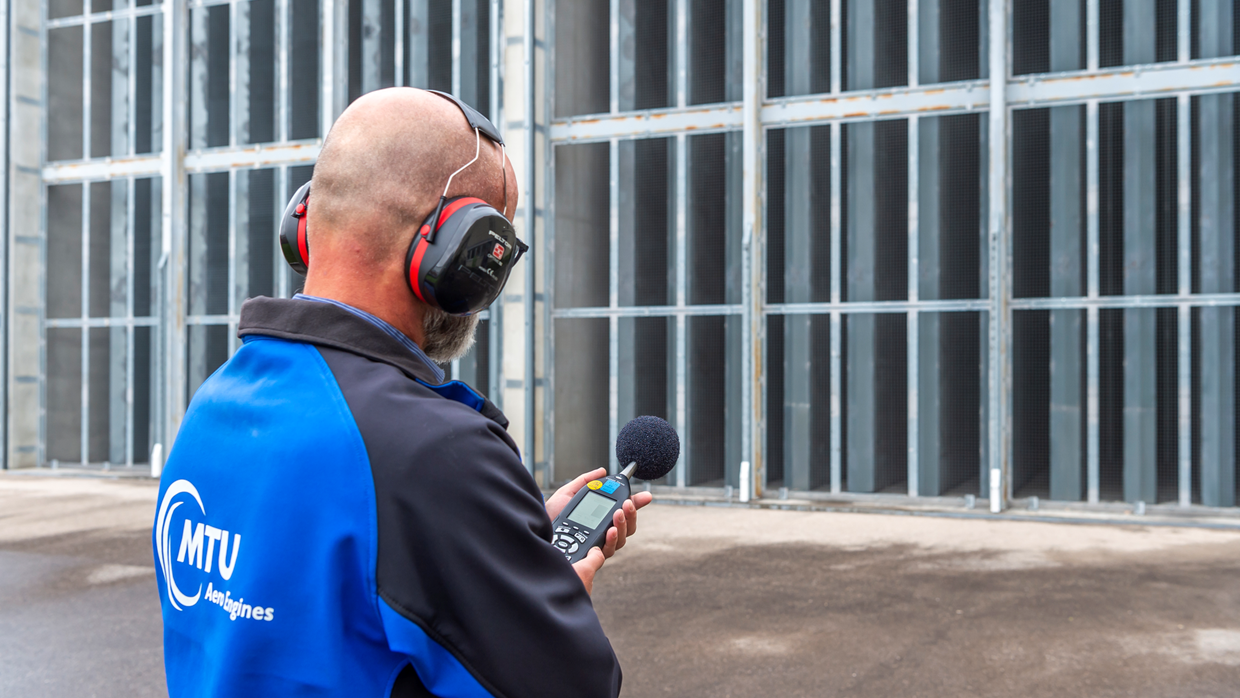Product
Health impact of aircraft engines
Our product development team is working to make aviation considerably quieter and cleaner. Reducing aircraft noise and exhaust emissions are declared goals of our Clean Air Engine technology agenda. Our revolutionary propulsion concepts open up completely new possibilities.

We are committed to active and integrated environmental protection that takes account of the significant impact our products have on the environment and society. Our efforts here take our commitment beyond climate action: with concepts for quieter and cleaner engines, we can improve the situation for residents living near and around airports in terms of noise pollution and local air quality. As with our approach to climate action, we have established several pillars to anchor the issue of aircraft noise in the company. In our global Code of Conduct, we commit to environmental protection and explicitly to reducing noise and exhaust emissions from aircraft engines. We want to set standards in this area, and we have formulated our goal accordingly. The MTU Principles also include the requirement to create products with lower noise and pollutant emissions under the heading “Environment & society.”
To receive certification from aviation authorities both aircraft and engines must meet noise and emissions limits set by the International Civil Aviation Organization (ICAO); in the past, these limits have been successively tightened. National aviation authorities are responsible for certification. Furthermore, at almost every airport in the world, the fees charged for takeoff and landing are dependent on the noise emissions of the aircraft model.
In the certification of new aircraft models, noise is measured using a standardized process at three defined points and then cumulated. Aircraft noise has decreased continuously since the 1960s, by a total of about 17 EPNdB (effective perceived noise decibels; a specific unit for measuring the relative noisiness of aircraft) or about 70%.
We support the noise targets of the European aviation industry
With our Clean Air Engine (Claire) technology agenda, we are pursuing not only climate action targets → Climate impact of aircraft engines, but also targets for reducing aircraft noise emissions. Achieving future noise limits is one of the agenda’s core elements. MTU’s acoustics experts are involved in our projects at every stage of product development, from technology management to subsequent propulsion system design and optimization.
When developing future propulsion systems, we support the goals of the European aviation industry and research sector’s Strategic Research and Innovation Agenda (SRIA), which calls to reduce noise to 65% of its 2000 levels by 2050. With the first-generation geared turbofan, which we offer together with our partner Pratt & Whitney, we have already significantly reduced aircraft noise emissions as part of Claire Stage 1. They are on average 15–20 EPNdB (cumulated over the three ICAO measuring points) below the current legally stipulated noise emission class, ICAO Stage 4.
Fast facts: Geared turbofan

smaller noise footprint

million flight hours

lower NOx emissions
Noise footprint describes the spread of aircraft noise in the sensitive area around airports, improvements based on 75 dB noise contour and in comparison to its predecessor
The geared turbofan from Claire Stage 1 has an architecture that harbors vast potential for further reducing noise compared to conventional turbofans. By making improvements to the latest generation, we want to achieve the goal of a 50% reduction in aircraft and engine noise emissions by 2035 (base year 2000).
According to the SRIA, new engine architectures are even to achieve a 65% drop in noise emissions by 2050 (base year 2000). Our efforts here include our new propulsion concept, the (hydrogen-powered) Flying Fuel CellTM, which can achieve massive reductions in noise because the fan is the powertrain’s sole source of noise. Starting it 2035, it could initially be used on shorter routes in the feeder and regional aircraft sector, and later also fly on short- and medium-haul routes.
We want to reduce pollutants to zero
In addition to contributing to climate effects and generating noise, air traffic also has an impact on local air quality at airports and in surrounding areas. The combustion process in engines produces pollutants in the form of nitrogen oxides (NOx), carbon monoxide (CO), unburned hydrocarbons (UHC), and soot/particulate matter. In terms of the impact these have on health, NOx, and particulate matter emissions are the most significant. To obtain type certification, aircraft and propulsion systems must meet ICAO environmental standards. ICAO has defined limits for the levels of NOx, CO, UHC, and soot emitted by aircraft engines. All of the engines in which MTU holds a workshare meet the ICAO certification standards. Engines are also certified with regard to compliance with ultra-fine particle emissions. Unlike with noise emissions, we have less scope to influence NOx and particulate matter emissions and the health effects because the combustor is not part of our portfolio for commercial engine programs. We can make a difference here only indirectly by improving the efficiency of the engine. For example, with the geared turbofan we have succeeded in significantly reducing NOx emissions, which are 50% lower than those of its predecessor. Sustainable fuels can also make a big difference in this regard. In initial tests, the German Aerospace Center (DLR) has shown that particulate emissions from combustion are significantly lower with sustainable aviation fuels (SAFs) than with conventional aviation fuels. Using hydrogen as a fuel reduces them even further. More about SAF in the chapter Climate impact of aircraft engines
Our development of revolutionary propulsion concepts, which is part of our climate action activities, also holds great potential for reducing pollutant emissions. Our Water-Enhanced Turbofan (WET) and Flying Fuel Cell (FFC) concepts can significantly reduce pollutant emissions or even avoid them altogether. WET works by injecting water into the combustor, which, based on what we know so far, can cut NOx emissions by over 80%. Hydrogen-powered fuel cells would actually emit nothing but water.